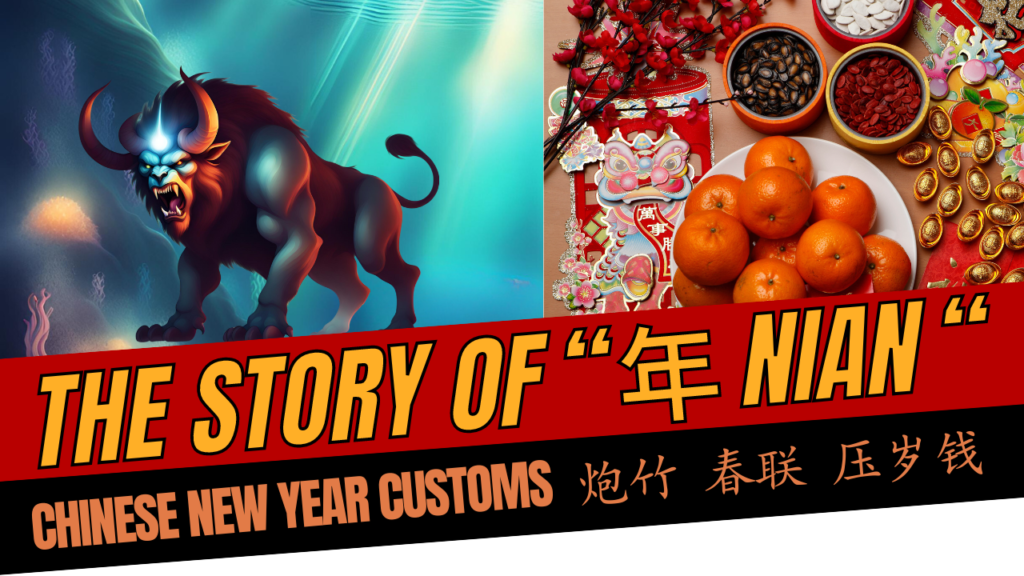Have you heard the story about “Nian年”? “年” means year in Chinese. But, the story is not about the Chinese word “年“ but rather about a ferocious beast called “年Nian” . This beast only comes out to attack villagers and animals during the Chinese New Year’s eve. When the beast was defeated by a beggar, villagers celebrated and it was on the 1st day of Lunar New Year.

The Story of Nian
Long ago, in ancient China, there was a monster called “Nian.” It had long antennae on its head and a very fierce appearance. “Nian” lived year-round at the deepest depths of the sea, only crawling ashore to devour livestock and bring calamity to humanity on New Year’s Eve. Therefore, every New Year’s Eve, villagers would escape to the deep mountains to avoid the harm of the “Nian” beast. On one New Year’s Eve, as the villagers were preparing to flee to the mountains, an old beggar arrived at the village. He is holding a stick and a bag in his arms, with long white beard, and his eyes radiate a unique glow. At this moment, the villagers were busy packing their belongings, herding cattle, and sheep, creating a scene of chaos and noise, with no one paying attention to the old beggar.
The old beggar
Only an old lady in the eastern part of the village pitied the old beggar, gave him some food, and advised him to hurry up the mountain to escape the “Nian” beast. The old beggar laughed and said, “If you let me stay here for one night, I will definitely drive away the ‘Nian’ beast.” The old lady did not respond, just carefully observed the old beggar. She noticed his white hair, baby face, strong spirit, and unusual posture. While preparing to evacuate, the old lady continued to persuade. The old beggar just smiled and said nothing more. Helpless, the old lady had to leave her home and seek refuge in the mountains.
What does Nian fear?
In the middle of the night, the “Nian” beast invaded the village. When it reached the house of the old lady in the east, it felt that the atmosphere in the village was different from before. The door of the old lady’s house was decorated with red paper, lit with candles, and the interior was brightly lit. The “Nian” beast trembled all over, making strange noises. Later, in a fit of rage, it headed towards the old lady’s house, attempting to ram the door with its body. When it was about to reach the doorway, it suddenly heard “bang bang pop pop” sounds from the garden. The beast began to tremble all over and dared not advance. It turned out that “Nian” was most afraid of the color red, firelight, and explosive sounds.
Lunar New Year Celebration
At this moment, the door of the old lady’s house opened wide, and the old beggar, wearing a red robe, walked out laughing heartily. The “Nian” beast was startled, panicked, and fled back to the deep sea. On the second day, which was the first day of the lunar new year, the villagers who returned from refuge were astonished to see the village unharmed. At that moment, the old lady remembered what the old beggar had said to her and quickly told the villagers. When the villagers arrived at the old lady’s house, they found red paper on the door, bamboo in the courtyard still making “pop pop” sounds, and several red candles inside still emitting a faint glow. To celebrate this joyous occasion, the villagers dressed in new clothes, wore new hats, and went to congratulate and greet friends and relatives. This story quickly spread to surrounding villages, and everyone learned how to get rid of the wild “Nian” beast. Since then, every New Year’s Eve, every household uses red paper to write couplets and paste them on the doors. They also set off firecrackers and fireworks. Each family lights candles, creating a festive atmosphere with lights celebrating New Year’s Eve. On the morning of the first day of the lunar new year, people get up early and visit relatives and friends to exchange New Year’s greetings. This tradition has been passed down to the present day, becoming the most grand and traditional folk festival in China.
Lunar New Year Customs
Firecrackers
Spring Couplets
Red Packets / Hong Bao
